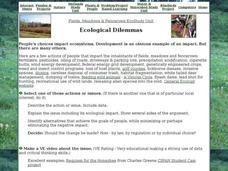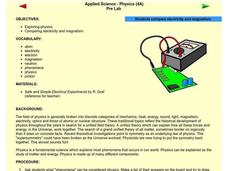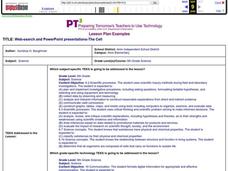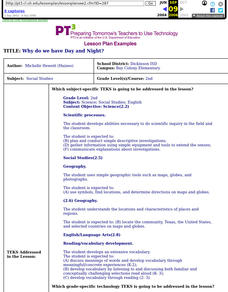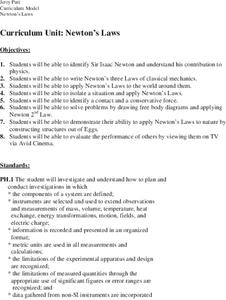Curated OER
Caverns: Drip Rate Analysis
Students tour a cave and collect water samples. They measure the drip rate from several locations inside the cave and discover the part water plays in cave formation.
Curated OER
Kitchen Chemistry
Fifth graders examine both physical and chemical changes, and how to identify the difference between the two. They observe the changes that occur in butter when it is exposed to heat and cold, heat energy. In their notebooks, they write...
Curated OER
Exploring The Great Salt Lake
Second graders experiment with sand samples taken from a lake. They use this as part of an inquiry that is based on observations. The properties of the sand are observed in the lab and recorded in writing. Prior to the lab students...
Curated OER
Teaching Animal Rights
In this biology instructional activity, students engage in the reading of the rights of educators to teach concerning the issue of using animals for educational purposes.
Curated OER
Starch Yer Thinkin' About Corn Products
Seventh graders study the parts of corn and explore the role of starch. In this corn products lesson students prepare a model of water and stones.
Curated OER
Finding Probability
Sixth graders explore the math concept of probability. In this probability lesson, 6th graders examine visual examples of finding probability. Students also practice solving problems that their instructors model.
Curated OER
Two-Dimensional Drawings from Three Dimensional Objects
Sixth graders identify and replicate two dimensional illustrations of three dimensional objects. In this spatial visualization lesson, 6th graders practice viewing objects from various sides. Student participate in stations to view...
Curated OER
Ecological Dilemmas
In this ecological dilemmas worksheet, students read about people's impact on ecosystems. Students complete 3 activities that require them consider the negative impact humans have on their environment.
Curated OER
Electricity and Magnetism
Fourth graders compare electricity and magnetism. In this science lesson, 4th graders discuss the concepts of electricity and magnetism and brainstorm examples of electrical and magnetic forces.
Curated OER
Photodocumentation: Promoting Environmental Education Through the Development of Visual Literacy Skills
Students construct a photo document on their selected topic and use at least twelve photographs in their photo document. One must be of the authors. Additionally, they must write five interactive questions which help viewers interpret...
Curated OER
Web-search And PowerPoint Presentations-The Cell
Sixth graders create a PowerPoint presentation using information that they have compiled from their web search and rubric web sites, text and other applicable references. They work in pairs to complete these searches and projects.
Curated OER
Why Do We Have Day And Night?
Second graders demonstrate knowledge and appropriate use of hardware components, software programs, and their connections. After a lecture/demo, student groups utilize raisins and apples to demonstrate day and night. They put togethre a...
Curated OER
Bird Populations
Students gather data about bird populations. They study bird migratory patterns using the methods that researchers use. They write an essay explaining the differences between the four types of population movements.
Curated OER
Floods: Rising Waters and You
Students examine the relationship between human-made structures, flood waters and the increasing population through video clips, websites and a lab experiment.
Curated OER
Travel Time
Students use a migration map to estimate the distance traveled by a bird while migrating south. After calculating accurate estimates of the distance traveled, students compare the distances traveled with the amount of time elapsed.
Curated OER
Exhaust, Gas and Pollution
Students watch a demonstration of how bromthymol blue is used to indicate the presence of carbon dioxide in a gas. They design their own experiments to test gasses which are suspected of containing carbon dioxide.
Michigan Sea Grant
Water Quality
Learners observe water samples and measure the samples' water quality. Students develop their own criteria for measuring water quality and test for temperature, acidity, oxygen levels, turbidity, conductance, sediment and hardness.
Curated OER
Observing and Recording Biological Data
Learners create their own definition of life. They identify the eight characteristics of life in organisms. They compare and contrast the characteristics of living and nonliving things.
Curated OER
Newton's Laws
Students examine and discuss Newton's Laws and discover his contribution to physics. In groups, they participate in an experiment in which they much apply the Laws to the world around them. They describe contact and conservative forces...
Curated OER
Real Family Genetics
Learners research genetic disease and mutation causing traits in family pedigrees simulated in a class activity. Students are each assigned a genetic trait and a "spouse" and must conduct research on their traits and the probability of...
Curated OER
Magnets 1: Magnetic Pick-ups
Students are introduced to the power of magnets. In groups, they look at different objects and make predictions on whether they believe they are magnetic or not. They test their predictions and share their results with the class.
Curated OER
Gearing up for Grammar
Students input autobiographical information to apply in a Diamante' poem that utilizes the different parts of speech. Students interact with each other sharing their autobiographical information completed on the database created....
Curated OER
Circuit Lab
Students explore the properties of electricity. This lab shows students the need for a circuit in order to have a flow of electricity. It demonstrates Ohm's law, which relates voltage, current, and resistance.
Curated OER
Problem Based Learning
Students increase problem solving skills. They research computer-related crimes, classifying them into the types of crimes. Students create a crime report. They present a presentation to the class.









